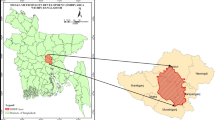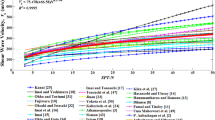Abstract
Shear wave velocity is an important input parameter for dynamic ground analysis. Standard penetration test blow counts, static cone penetration tip resistance and shear wave velocity (VS) obtained by the cross-hole technique have been collected from a large number of projects in Greece over the last 10 years and regression analysis used to develop empirical relationships. The paper discusses the factors which influence the derived equations, in particular the relevance of the soil type.
Résumé
La vitesse des ondes de cisaillement est un paramètre important pour l’analyse du comportement dynamique des sols. Les résultats d’essais pénétrométriques SPT, les résistances de pointe au pénétromètre statique et les mesures de vitesses d’ondes de cisaillement (VS) obtenues par les techniques cross-hole ont été rassemblés à partir d’un nombre important de projets en Grèce sur les dix dernières années. Des analyses de régression ont été réalisées pour obtenir des relations empiriques. L’article discute des facteurs explicatifs relatifs aux équations obtenues, en considérant en particulier les types de sols.





Similar content being viewed by others
References
Anagnostopoulos A, Koukis G, Sabatakakis N, Tsiambaos G (2003) Empirical correlations of soil parameters based on cone penetration tests (CPT) for Greek soils. Geotech Geol Eng 21:377–387
Andrus RD, Hayati H, Mohanan NP (2009) Correcting liquefaction resistance for aged sands using measured to estimated velocity ratio. J Geotech Geoenviron Eng 135(6):735–744
ASTM (1991) Standard test methods for cross hole seismic testing (D 4428/D4428/M)
ASTM (1992) Standard test method for penetration test and split-barrel sampling of soils (D 1586)
ASTM (1994) Standard test method for deep, quasi-static cone and friction-cone penetration tests of soil (D 3441)
Athanasopoulos G (1994) Empirical correlations VSO–NSPT and Go–NSPT from test results on soils of Greece. Techika Chronika 14(1):7–28 in Greek
Baldi G, Belloti R, Ghiona VN, Jamiolkowski M, Pasqualini E (1986) Interpretation of CPT’s and CPTU’s—2nd part: drained penetration of sands. IV International geotechnical seminar on field instrumentation and in situ measurements, Nayang Technological Inst., Singapore, pp 143–156
Borcherdt RD (1994) Estimates of site dependent response spectra for design methodology and justifications. Earthq Spectra 10(4):617–654
Bouckovalas G, Kalteziotis N, Sabatakakis N, Zervogiannis H (1989) Shear wave velocity in a very soft clay—measurements and correlations. In: Proceedings of the 12th international conference on soil mechanics and foundation engineering, Rio de Janeiro, 13–18 August, pp 191–194
Burland JB (1989) Small is beautiful—the stiffness of soils at small strains. Can Geotech J 26(4):499–516
Christoulas S, Kalteziotis N, Tsiambaos G, Sabatakakis N (1987) Engineering geology of soft clays. Examples from Greece. Embankment on soft clays, Bulletin of the Public Works Research Center, Special Publication, pp 3–33
Dobry R, Borcherdt RD, Crouse CB, Idriss IM, Joyner WB, Martin GR, Power MS, Rinne EE, Seed RB (2000) New site coefficient and site classification system used in recent building code provisions. Earthq Spectra 16(1):41–67
EN-ISO-22476-3 (2003) Geotechnical investigation and testing–Field testing—Part 3: standard penetration test. Technical Committee CEN/TC 341
Fujiwara T (1972) Estimation of ground movements in actual destructive earthquakes. In: Proceedings of the 4th European Symposium on Earthquake Engineering, London, pp 125–132
Hasancebi N, Ulusay R (2007) Empirical correlations between shear wave velocity and penetration resistance for ground shaking assessments. Bull Eng Geol Environ 66:203–213
Hayati H, Andrus RD (2009) Updated liquefaction resistance correction factors for aged sands. J Geotech Geoenviron Eng 135(11):1682–1692
Imai T (1977) P and S-wave velocities of the ground in Japan. In: Proceedings of the IX international conference on soil mechanics and foundation engineering, Japan, vol 2:127–132
Imai T, Tonouchi K (1982) Correlation of N-value with S-wave velocity and shear modulus. In: Proceedings of the 2nd European symposium of penetration testing, Amsterdam, pp 57–72
Imai T, Yoshimura Y (1970) Elastic wave velocity and soil properties in soft soil (in Japanese). Tsuchito-Kiso 18(1):17–22
Jafari MK, Shafiee A, Ramzkhah A (2002) Dynamic properties of the fine grained soils in South of Tehran. J Seismol Earthq Eng 4(1):25–35
Jamiolkowski M, Ghionna VN, Lancellotta R, Pasqualini E (1988) New correlations of penetration tests for design practice. In: Proceedings of the 1st international symposium on penetration testing, ISOPT-1, Orlando, vol 1, pp 263–296
Jongmans D, Campillo M, Demanet D (1990) The use of surface waves inversion and seismic reflection methods for engineering applications. In: Balkema AA (ed) Proceedings of the 6th congress of international association for engineering geology and the environment (IAEG), Amsterdam, pp 979–985
Kalteziotis N, Sabatakakis N, Vassiliou J (1992) Evaluation of dynamic characteristics of Greek soil formations. In: Proceedings of the 2nd Hellenic conference on geotechnical engineering, vol 2, pp 239–246 (in Greek)
Kitsunezaki C (1980) A new method for shear-wave logging. Geophysics 45(10):1489–1506
Kokusho T, Yoshida Y (1997) SPT N-value and S-wave velocity for gravelly soils with different grain size distribution. Soils Found 37(4):107–113
Koukis G, Sabatakakis N, Tsiambaos G, Katrivesis N (2005) Engineering geological approach to the evaluation of seismic risk in metropolitan regions: case study of Patras, Greece. Bull Eng Geol Environ 64(3):219–235
Lee SHH (1992) Analysis of the multicollinearity of regression equations of shear wave velocities. Soils Found 32(1):205–214
Mayne PW, Rix GJ (1995) Correlations between shear wave velocity and cone tip resistance in natural clays. Soils Found 35(2):107–110
Mokhtar TA, Hermann RB, Russell DR (1988) Seismic velocity and Q model for the shallow structure of the Arabian shield from short-period Rayleigh waves. Geophysics 53(11):1379–1387
Ohsaki Y, Iwasaki R (1973) On dynamic shear moduli and Poisson’s ratio of soil deposits. Soil Found 13(4):61–73
Ohta Y, Goto N (1978) Empirical shear wave velocity equations in terms of characteristics soil indexes. Earthq Eng Struct Dyn 6:167–187
Pitilakis K, Raptakis D, Lontzetidis K, Tika-Vassilikou T, Jongmans D (1999) Geotechnical and geophysical description of Euro-Seistests, using field and laboratory tests, and moderate strong ground motions. J Earthq Eng 3(3):381–409
Seed HB, Idriss IM (1981) Evaluation of liquefaction potential sand deposits based on observation of performance in previous earthquakes. ASCE Natl Conv, Missouri, pp 81–544
Stokoe KH, Nazarian S, Rix GJ, Sanchez-Salinero I, Sheu J-C, Mok YJ (1988). In: Von Thun JL (ed) In situ seismic testing of hard-to-sample soils by surface wave method. Geotech. Special Pub., No. 20, ASCE, New York, pp 264–278
Sykora DE, Stokoe KH (1983) Correlations of in situ measurements in sands of shear wave velocity. Soil Dyn Earthq Eng 20(1–4):125–136
Tsiambaos G (1991) Correlation of mineralogy and index properties with residual strength of Iraklion marls. Eng Geol 30:357–369
Uma Maheswari R, Boominathan A, Dodagoudar GR (2009) Use of surface waves in statistical correlations of shear wave velocity and penetration resistance of Chennai soils. Geotech. Geol Eng (doi:10.1007/s10706-009-9285-9)
Acknowledgments
Part of this work carried out under a research project sponsored by the Greek Earthquake Planning and Protection Organization (EPPO) and the authors gratefully acknowledge this support.
Author information
Authors and Affiliations
Corresponding author
Rights and permissions
About this article
Cite this article
Tsiambaos, G., Sabatakakis, N. Empirical estimation of shear wave velocity from in situ tests on soil formations in Greece. Bull Eng Geol Environ 70, 291–297 (2011). https://doi.org/10.1007/s10064-010-0324-9
Received:
Accepted:
Published:
Issue Date:
DOI: https://doi.org/10.1007/s10064-010-0324-9
Keywords
- In situ testing
- Shear wave velocity
- Standard penetration test
- Cone penetration test
- Dynamic soil properties




